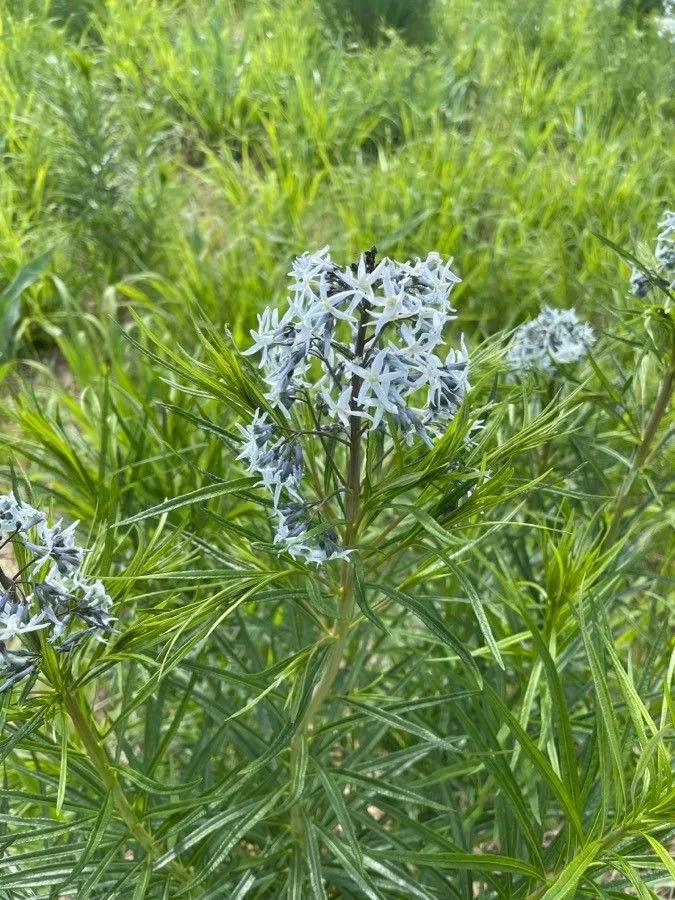
Author: Walter
Bibliography: Fl. Carol.: 98 (1788)
Year: 1788
Status: accepted
Rank: species
Genus: Amsonia
Vegetable: Unknown
Observations: C. & SE. U.S.A.
Fringed bluestar, known scientifically as Amsonia ciliata, is a fascinating and visually captivating plant that belongs to the Apocynaceae family. Originally described in the seminal work “Fl. Carol.: 98” by botanist Thomas Walter in 1788, this species has maintained a cherished place in the botanical world.
Primarily observed across the central and southeastern regions of the United States, Fringed bluestar thrives in these locales, making its home in the temperate climate of these areas. This perennial plant is renowned for its striking aesthetic appeal, which contributes to its popularity among gardeners and nature enthusiasts alike.
One of the most distinguishing features of Fringed bluestar is its delicate flowers. The bloom clusters are composed of star-shaped blossoms, typically in soft shades of blue or sometimes white, that appear particularly enchanting in the sunlight. These flowers stand out against the backdrop of fine, thread-like foliage, giving the plant its characteristic “fringed” appearance.
Not only is Fringed bluestar celebrated for its beauty, but it also displays a noteworthy resilience and adaptability. It flourishes in well-drained soils and can often be found in rocky or sandy environments, making it an excellent choice for a wide range of garden settings, including native plant gardens and more traditional landscapes. The plant’s ability to withstand drought conditions further underscores its versatility.
In addition to its horticultural merits, Fringed bluestar plays a beneficial role in local ecosystems. Its flowers attract a variety of pollinators, including butterflies, bees, and other insects, supporting biodiversity and promoting ecological balance in its native habitats.
In summary, Fringed bluestar (Amsonia ciliata) is a plant of considerable charm and ecological value. Its elegant, fringed flowers and hardy nature make it a delightful and practical addition to gardens and wild landscapes alike, continuing to captivate botanists and garden lovers since its initial classification by Thomas Walter in the 18th century.
Eng: texas slimpod, fringe slimpod, fringed bluestar
En: Fringed bluestar, FRINGE SLIMPOD, Texas slimpod
Fi: Nukkatuikki
Taken Apr 3, 2016 by EOL − Sam Kieschnick (cc-by-nc)
Taken Mar 24, 2016 by EOL − andy (cc-by-nc)
Taken Apr 8, 2016 by EOL − dagmar (cc-by-nc)
Taken Jun 9, 2022 by Jane Scarfe (cc-by-sa)
Taken May 13, 2021 by Cara P (cc-by-sa)
© copyright of the Board of Trustees of the Royal Botanic Gardens, Kew.
Taken Jun 3, 2022 by steven Levenberg (cc-by-sa)
Taken May 8, 2021 by Sebra Debrecht (cc-by-sa)
Taken May 8, 2022 by Lenore Roca (cc-by-sa)
Taken May 1, 2020 by Vivian Figueredo (cc-by-sa)
Taken Jun 15, 2021 by Julie Mirlycourtois (cc-by-sa)
Taken Apr 6, 2016 by EOL − griff (cc-by-nc)
Taken Apr 6, 2016 by EOL − Nicholas Martinez (cc-by-nc)
Taken Apr 6, 2016 by EOL − Nicholas Martinez (cc-by-nc)
Taken Dec 16, 2015 by EOL − Sam Kieschnick (cc-by-nc)
Taken Apr 3, 2016 by EOL − Sam Kieschnick (cc-by-nc)
Family: Myrtaceae Author: (F.Muell.) K.D.Hill & L.A.S.Johnson Bibliography: Telopea 6: 402 (1995) Year: 1995 Status:…
Family: Rubiaceae Author: Pierre ex A.Froehner Bibliography: Notizbl. Bot. Gart. Berlin-Dahlem 1: 237 (1897) Year:…
Family: Sapindaceae Author: Koidz. Bibliography: J. Coll. Sci. Imp. Univ. Tokyo 32(1): 38 (1911) Year:…
Family: Asteraceae Author: A.Gray Bibliography: Pacif. Railr. Rep.: 107 (1857) Year: 1857 Status: accepted Rank:…
Family: Fabaceae Author: Medik. Bibliography: Vorles. Churpfälz. Phys.-Ökon. Ges. 2: 398 (1787) Year: 1787 Status:…
Family: Aspleniaceae Author: (Cav.) Alston Bibliography: Bull. Misc. Inform. Kew 1932: 309 (1932) Year: 1932…